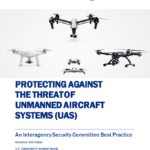
This document provides guidance for federal Executive Branch departments and agencies regarding best practices, lessons learned, and recommendations to protect against the threat of malicious unmanned aircraft systems (UAS) operations.
The Robotic Aircraft for Public Safety (RAPS) project will invite SUAS vendors to a chosen location and evaluate each system using key performance parameters under a wide variety of simulated but realistic and relevant real-world operational scenarios, such as law enforcement operations, search and rescue, and fire and hazardous material spill response. The SUAS vendors will provide technically mature, flight proven vehicles and their fully-integrated sensors for evaluation. Safety concerns will also be assessed such as the aircraft’s capability for safe flight in the event of a loss of communications between the aircraft and the ground controller.
“Enduring Airpower Lessons from Operation ENDURING FREEDOM (OEF) and Operation IRAQI FREEDOM (OIF)” is one of three lessons learned (L2) focus areas directed by the Chief of Staff of the Air Force (CSAF) at CORONA Top 2008. This report is the third and last in a series of Unmanned Aircraft Systems (UAS) L2 reports produced for fiscal year 2009 and focuses on Small UAS (SUAS) capabilities and issues.
The purpose of this handbook is to enhance understanding of Army airspace command and control (A2C2) to mitigate risks between small unit unmanned aerial vehicles (SUAVs) and rotary wing operations below the coordinating altitude. This handbook provides leaders at the brigade and below with guidelines in the form of airspace coordination techniques and procedures regarding SUAV mission planning and airspace deconfliction.